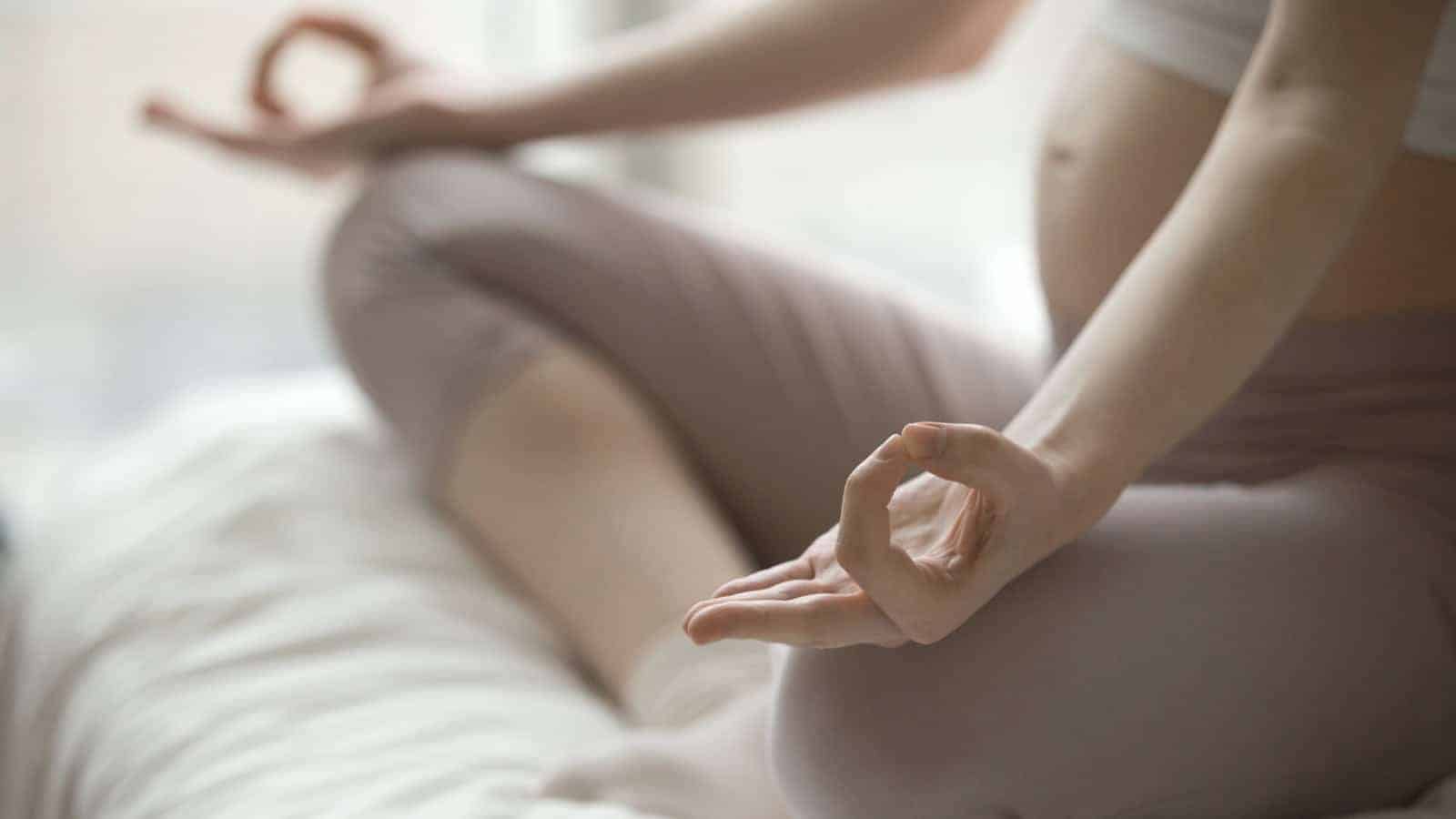While undoubtedly amazing experiences, pregnancy and labor are among the most physical and mentally proving moments of a woman’s life. Finding a practice that you can follow through during your pregnancy can help you feel healthier, more relaxed, and at ease. Specifically, safe yoga poses and breathing techniques can help you enjoy such a unique moment in all its beauty.
Safe poses for yogi moms include wide-knee child’s pose, goddess, cat-cow, and warrior II. Breathing exercises include long-deep and alternate nostril breathing. Start with light classes in the first trimester, then adapt your prenatal yoga practice to the pregnancy phase you are in.
Safe yoga poses for moms can be greatly helpful during pregnancy, but you should also consider your level of expertise and, ideally, consult your OB/GYN before starting. Let’s find out what yogi moms should know about practicing yoga during pregnancy.
Prenatal Yoga – What You Need to Know
Yoga during pregnancy – or prenatal yoga – refers to the way of practicing yoga to train your body and mind for labor. The benefits of introducing this practice in your life have already been tested and certified. Indeed, yoga can help tone the muscles, focus your mind, relax, and build body awareness.
During pregnancy, these characteristics are especially important. Indeed, carrying your baby and going through labor is among the most physical experiences you will have in your life. So, tuning in to your body, strengthening your muscles, and refining the ability to concentrate and relax can make the whole experience much more enjoyable.
Yoga for Moms to Be – A Word of Caution
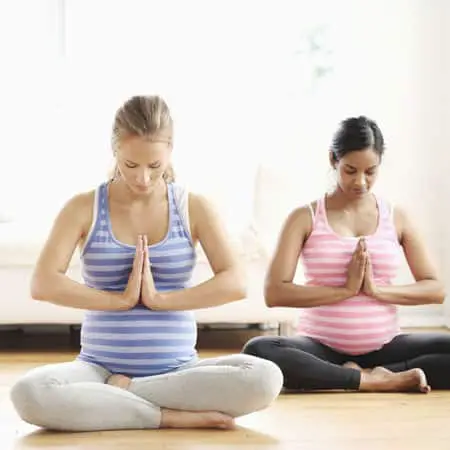
As we have seen, practicing yoga during pregnancy can be ideal for women whose practice is already strong and just starting out. In any case, moms to be should keep in mind a few different aspects of pregnancy.
Firstly, the first trimester is the most delicate one, especially because the fetus is not settled yet, and the chances of miscarriage are at their highest. It is recommendable to modify your current routine to avoid adding any strain on the body during this time. You can do so by dedicating your time to breathing exercises and mindfulness instead.
Then, you might decide to restart implementing other poses. However, you should stay clear of inversions and twists. The firsts might imply a higher risk of falls and injuries, while the second add pressure to the abdomen.
Additionally, during balancing poses, you should always opt to support your practice with blocks and props. Indeed, during pregnancy, your center of gravity might have shifted forward, so it is crucial to practice without the risk of falling.
So, if your yoga practice is already strong, you should think about modifying it to ensure that you are reflecting on the changes happening in your body. If you are still a newbie, speaking to a prenatal yoga teacher might be extremely recommendable.
Before jumping on your mat, make sure you have taken all the necessary precautions and consulted with your OB/GYN. These professionals are the ones that can tell you more about the safest way to keep up with your daily practice.
Check out an example of prenatal yoga class in the video below:
Corpse Pose
If you had been practicing yoga in the past, you would know this pose as the deep relaxation and restoration asana performed at the end of each class. This is considered the most important pose in yoga, and it is often used to give your body a chance to absorb the benefits of the practice you have just completed.
Also known as Savasana, this body posture is among the easiest to perform and master, but its benefits are endless.
How to Practice Savasana
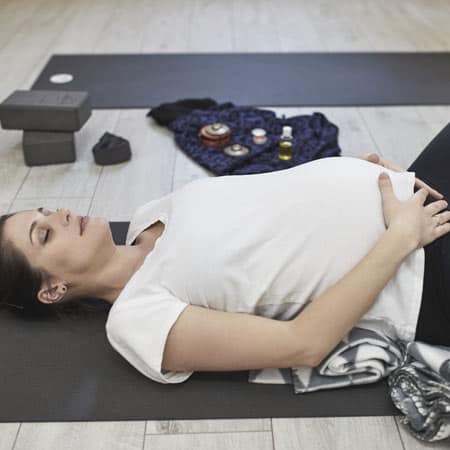
- Lie on your back on a duvet or yoga mat.
- Allow your hands to rest on the sides of your body and be completely relaxed.
- Turn your palms up and ensure that all limbs are positioned in a natural position, often slightly distanced from your body.
- Close your eyes
- Take the time you need to relax each body part, starting from your toes and working your way up through your body and to the top of your head.
You can perform Savasana on a yoga mat – with or without pillows to support your neck and legs – or on your bed at nighttime. Due to the deep feeling of relaxation it offers, this pose is ideal to start getting sleepy.
Warrior II Pose
Warrior II pose – or Virabhadrasana II – is one of the most powerful asanas in yoga and often part of most classes. Practicing this pose offers many physical benefits, including:
- Strengthening and energizing the legs
- Opening the hips and shoulders
- Opening your lungs and chest
- Relieving back pain (useful especially during the second trimester)
- Improves balance and blood circulation
At the same time, Warrior II can help increase self-confidence levels, build stamina, and encourage deep focus.
How to Practice Warrior II
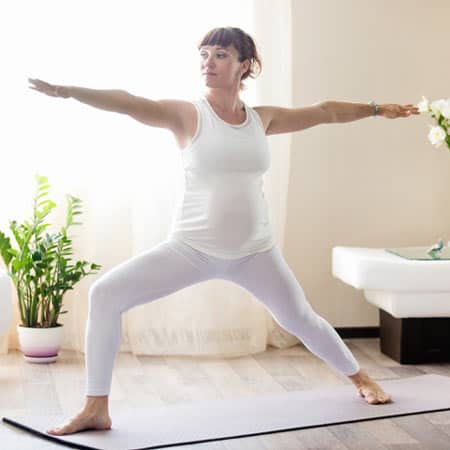
- Start in Standing Mountain Pose (Tadasana).
- Move your feet 3 to 4 ft (0.9 to 1.2 meters) apart from each other – do so along with an exhale.
- Lift your arms, with the palms facing down, until they are parallel to the floor.
- Turn your back foot towards the edge of the mat, positioning at a 90° angle.
- Turn the front foot a little towards the opposite way, so the heel of your front foot is on the same line of the heel of your back foot.
- As you exhale, bend the front knee to bring the thigh parallel to the floor.
- Press the tailbone down and keep your spine straight while you extend your arms. Do not lean forward.
Cat-Cow
Cat-cow, or cat-cow stretch, is a combination of two poses: cat pose (Marjaryasana) and cow-pose (Bitilasana). This gentle vinyasa is ideal for bringing a little movement into your practice, without adding strain to your abdomen or muscles.
This vinyasa can help you improve balance and stretch your spine and neck. However, the real benefits of this combination of poses derive from the fact that, as you synchronize your breath with your movement, you can refine your coordination skills and relax the body.
How to Practice Cat-Cow
- Start in a flat-back, tabletop position with your knees as wide as your hips and in line with your wrists.
- As you inhale, slowly transition into cow-pose by lifting your neck, face, and tailbone. At the same time, drop your belly.
- As you exhale, transition into cat-pose by arching the spine and dropping the head.
- Continue breathing deeply and smoothly while you repeat the sequence.
Bound Angle Pose
While the previous postures are ideal for lowering stress levels and managing mental pressure, Bound Angle Pose – or Baddha Konasana – is ideal for opening the hips and the groin.
By practicing such a posture, you can create space between the hips and practice for birth-giving.
How to Practice Bound Angle Pose
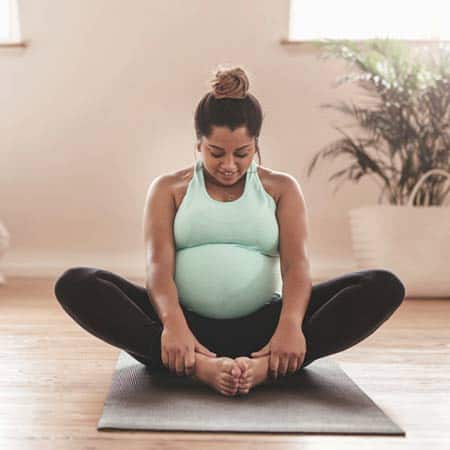
- Sit on the ground, on your yoga mat.
- Bring the feet in front of you, allowing the bottom of the feet to touch. You might recognize this as the butterfly pose.
- Wrap both of your hands around the feet and sit tall.
- Now, start breathing deeply and straighten the spine.
- Once you are comfortable and in position, use your hands to lean gently lean forward. This will deepen the stretch.
Goddess Pose
The goddess pose is ideal if you feel that you should improve your lower body’s strength and stability. The pose specifically targets the tight inner areas, as well as glutes, quads, abductors, abs, lower back, hamstrings, and obliques. These are considered the main stabilizers, and, by strengthening them, you can benefit from better balance and stability.
How to Practice Goddess Pose
- Start standing, while keeping your feet a little wider than the shoulders.
- Slightly rotate the toes outwards, allowing them to set at a 45°. Make sure the knees are stacked above the feet and facing the second toe of each foot.
- Stand straight and ensure that your spine is erect. Bring your eyes forward.
- While inhaling, bend the knees forward, creating a 90° angle between your upper and lower legs.
- As you exhale, press up back to standing, controlling the movement until you are straight again.
Ankle-to-Knee Pose
The ankle-to-knee pose, also known as Agnistambhasana, is an intermediate yoga posture used as a hip-opener. It allows the hip joint to move through its full range of motion, which can be extremely helpful in increasing mobility and relieving back pain.
This asana is particularly suitable for women who are at risk of back pain or sciatica due to lifestyle or consequences of pregnancy. This condition, which arises as a consequence of an inflammation of the sciatic nerve, affects over two-thirds of pregnant women, and it is deemed to be the leading cause of back pain.
Hip-opening poses such as the ankle-to-knee postures can not only help you relieve the symptoms caused by sciatica but also prevent the condition altogether.
How to Practice Ankle-to-Knee Pose
- Start in a comfortable cross-legged seated position. Use a mat or blocks as support.
- Move your right shin, so it is located parallel to the edge of the mat.
- Move your left ankle on top of the right knee, so the left shin is now parallel to the right shin and the edge of the mat.
- Inhale and exhale while flexing your feet.
- Repeat on the other side.
Standing Forward Bend
This is another excellent pose that can help you relieve the back pain so common in pregnant women. While it is easy to practice and master, the Standing Forward Bend pose – also known as Uttanasana – can be modified to fit your specific needs, and it is easy on the knees. If your hips are not so mobile, the Standing Forward Bend can be an accessible solution.
How to Practice Standing Forward Bend
- Begin in a standing position such as a mountain pose with your feet wider than your hips. Keep your knees slightly bent, while the hips should be level.
- Without locking the knees, start to bend forward the waist.
- Allow the head to drop toward the mat.
- For a deeper stretch, bend your elbows and grab them with the opposite hands – a movement that helps to stretch the spine a little longer.
- Stay as long as it feels comfortable while keeping your breathing smooth and deep.
Seated Side Bend
Practicing seated side ankle is an excellent addition to your daily prenatal yoga practice. A side ankle – whether you prefer to perform it with your legs straight in front of you or in a seated position, is the ideal posture to stretch the sides of your back.
When coupled up with Standing Forward Ben and Mountain Pose, it allows you to stretch the whole of your spine and relieve back pain.
How to Practice Seated Side Bend
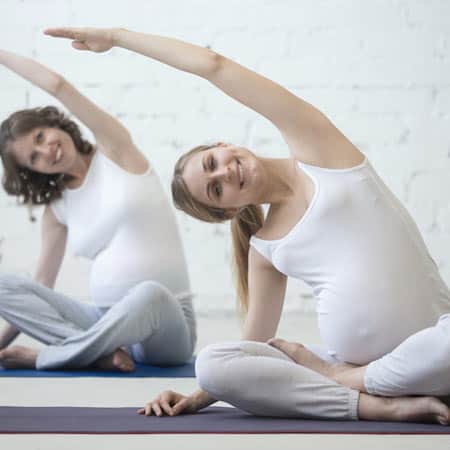
- Start by sitting down on your yoga mat, in a cross-legged position or with the legs straight in front of you.
- Sit with your back tall and erected.
- Lift one of your arms in the air and start tilting towards the opposite side.
- While doing so, ensure that the extended arm is a continuation of your body and remains in line with the side. It should not lean forward or towards the back of your body.
The more you stretch on the side, the deeper the stretch will be. Just ensure that you are not feeling any pain or discomfort.
Yoga Squat (Supported With a Block)
Practicing yoga squat, whether you decide to use a block or not, is an excellent way to open your hips and ankle while relaxing the spine. This posture, known as Garland Pose or Malasana, is considered among the best asanas for pregnant women. It can help you train your hips and increases the pelvic floor muscle strength.
If you have been practicing yoga, but you could not quite master this pose, you should try again. Indeed, during pregnancy, the body releases the relaxin hormone, which is bound to make you feel more flexible.
How to Practice Yoga Squat
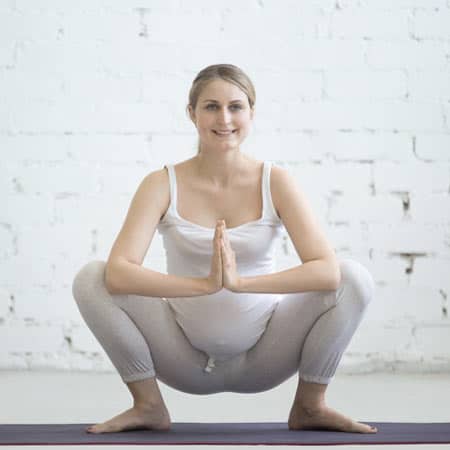
- Sit on the block with both legs in front of you.
- One at a time, bring the feet closer to your seat, a little wider than your hips.
- Shift your body weight onto the feet and lift off the ground or the block.
- While in the squat position, remember to keep your back straight. Many yogis join their hands in prayer and use the elbow to push against the knees slightly. This can increase stability and stretch.
Wide-Knee Child’s Pose
This yoga posture for rest and deep relaxation is ideal for fighting the stress associated with pregnancy. While there are several variations you could be experimenting with, the wide-knee alternative ensures that you are not adding pressure to your abdomen, which can expand fully.
How to Practice Wide-Knee Child’s Pose
- Start from all fours, with your knees as wide as the yoga mat.
- Bring the toes together, so they touch each other.
- Sit back on your heels. Stretch the arms forward, relaxing them as your forehead touches the yoga mat.
- Keep the position for several deep breaths and stay here until it feels good.
Wide-Angle Seated Forward Bend
Known in yoga as Upavistha Konasana, the Wide-Angle Seated Forward Bend is a pose that can take you some practice to find comfortable. However, this is excellent to stretch the back and the legs and allows you to take the weight of your belly off your limbs and lower back for a few minutes.
How to Practice Wide-Angle Seated Forward Bend
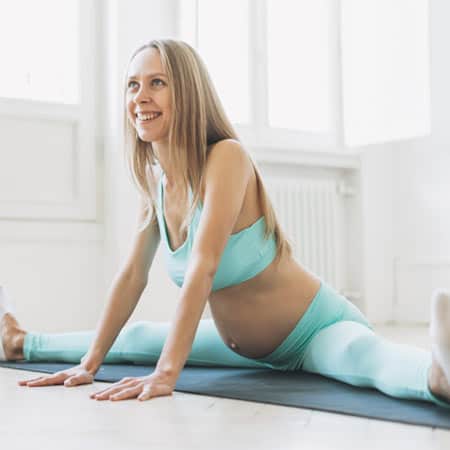
- Start this posture seated on your yoga mat with your legs in front of you.
- Bring the legs apart, as far as your hips allow. Avoid adding additional strain to the hips.
- Sit tall and keep your spine erect.
- Keeping a flat back, start to lean forward, placing the forearms in front of you.
- While you should feel the stretch in your hips, you might not be at the point to touch the floor with your forearms. Keep breathing and maintain the position to allow your body to stretch a little further.
Dolphin Pose
If you have been practicing downward dog, this pose will come naturally to you. However, unlike a downward dog, this posture aims to strengthen the arms and torso. Aside from adding strength, this pose can help you open your upper back and shoulders.
How to Practice Dolphin Pose
- Start from an all-fours or tabletop position.
- Tuck your toes in and start lifting your hips and tailbone toward the ceiling. Straighten your legs as you do so.
- Attempt to keep your legs straight as you stay in this downward dog version.
- Then, slowly, lower your forearms, allowing them to touch the mat.
- Continue to keep your hips elevated and a neutral neck.
Fish Pose (Supported With Blocks)
The Fish Pose can be a fantastic way to open the chest, lungs, hips, and heart. It can help you relax your lower back and allow you to relieve stress. However, you must use props and avoid any significant backbend. Indeed, your abdomen is already stretched, and you don’t need to stretch it any further.
Using blocks and props – or just a rolled towel under your shoulders – can be an effective way to feel the stretch without running any risk.
How to Practice Fish Pose
- Get ready by grabbing two yoga blocks.
- Start in a seated position and set one block a few inches behind you on the lowest setting.
- Place the other block further away from the one you have just placed (in the highest or middle setting).
- Bend your legs, so the feet’ bottom is touching each other (butterfly pose), and the knees are relaxed on the sides.
- Start lowering yourself. Your mid-back, upper neck, and head should rest on the two blocks you have placed.
- Take your time to place the blocks in a location where they feel comfortable, then rest with your arms relaxed on the side of the body.
Legs-Up-the-Wall Pose
While pregnant, several changes are happening in your body. One of the main ones happens in the cardiovascular system. Indeed, your body gets ready to deliver more blood and oxygen around the body to fulfill the growing fetus’s supply. So, it starts to pump up to 50% more blood, much faster (over 30%) than usual.
While this is only a sign that the fetus is healthy and growing, and your body is naturally adapting, it can create blood circulation and pressure problems.
Luckily, certain yoga poses can help to restore normal blood circulation and relieve leg fatigue and swelling. Generally, it is suggestable to always sit with your feet elevated. However, when you are on your mat, you could practice this pose to find relief.
How to Practice Legs-Up-the-Wall Pose
- Move your yoga mat closer to a wall and sit just by the wall.
- Lie on the mat while looking up and raise your legs.
- Your flexed feet should face the ceiling.
- Move your hips a little, so the heels and calves can reach the wall without issue.
- Move your hand, so one of them is in your heart space, and one is on your belly.
Breathing Exercises
Most of the asanas and vinyasa in yoga lose some value if they are not combined with steady and deep breathing. Therefore, learning how to synchronize your movements and your breathing is paramount. However, there are also certain breathing exercises, or Pranayama, that you can benefit from at any point in your pregnancy and help you focus and relax.
These include:
Prenatal Yoga – What to Expect
Preparing for Labor Through Yoga
Angela Gallagher, a prenatal and postnatal yoga teacher who researched at the Active Birth Center in London, England, makes us aware that labor is extremely physical. And, just like in the case of marathons and other physical exercises, you would not attempt it without proper training. So, starting to train for labor becomes paramount.
Prenatal yoga practice has been seen as extremely helpful in supplying moms to be with the necessary training to live through this experience in total serenity. Indeed, yoga can help you understand your body better, tune in with the pelvic floor, and strengthen your legs and hips.
Meditation Can Help You Relax and Concentrate
Aside from yoga’s physical benefits, this practice addresses another essential aspect of pregnancy and birth-giving: stress and psychological pressure.
Undoubtedly, such pressure might derive from worries regarding the baby’s health and your ability as a parent. Such high levels of stress are often related to sudden mood changes, a change in metabolism, fatigue, and hormones such as progesterone and estrogen. At the same time, constant or excessive stress can harm you and your baby.
Yoga, as well as other mindful practices such as meditation and breathing exercises, can help you manage stress and relax. This is essential both during pregnancy and labor, a moment in which remaining calm and focused is essential.
Some Standing Postures Can Increase Strength
One of the main reasons for anybody starting yoga is to strengthen the body and mind. However, during pregnancy, this practice might become essential to keep fit, which, in turn, is essential to deal with the discomfort and pressure.
It is not unlikely to hear from moms to be suffering from poor circulation, leg discomfort, and back pain. Undoubtedly, the extra weight they must carry during the nine months greatly affects the body.
At the same time, strenuous exercise is not recommendable at any point during the pregnancy journey. So, yoga presents itself as a viable alternative that can help you strengthen the body while not adding any additional stress if done well and mindfully.
Class Can Help You Build a Sense of Community
If you are considering the benefits of yoga classes during pregnancy, you can’t ignore that just joining such a class can be extremely helpful. Indeed, you will find women going through the same journey – something that can help you find the answers you need.
Practice Can Help You Tune In With Your Body
By increasing your level of flexibility and strength, yoga can help you tune in with your body. Through mindfulness exercises and meditation, you will be able to gain an enhanced level of body awareness. So, during the last few days of pregnancy and labor, you can make more conscious decisions about the right treatments and medications.
Indeed, Harvard Health Publishing mentions that yoga practitioners are more tolerant of pain and better understand their bodies. This, along with the fact that this practice has been seen to increase mobility and lower discomfort in individuals with chronic pain diseases, shows suggest that practicing yoga during pregnancy can make you feel more relaxed and at ease.
Conclusion
Yoga has been seen to have incredible benefits on the body and mind. However, this practice is especially important during pregnancy, when strenuous and higher-impact training types are not recommendable. Some of the best poses to increase hips flexibility, strengthen the muscles, and clear the mind include child’s pose, corpse pose, and warrior II.
However, don’t forget to couple up your daily practice with regular breathing exercises to relax and focus the mind. Lastly, moms should always check in with their OB/GYN before starting, independently on how strong their yoga practice already is.

